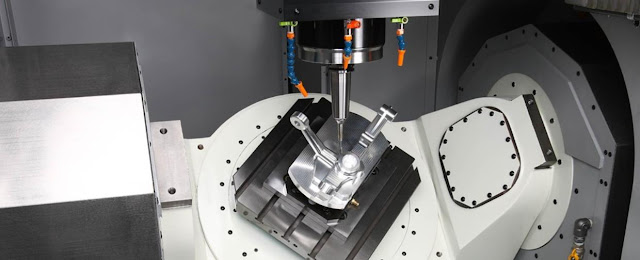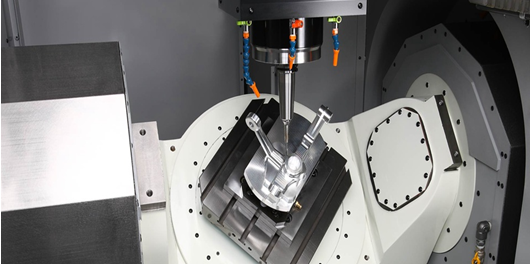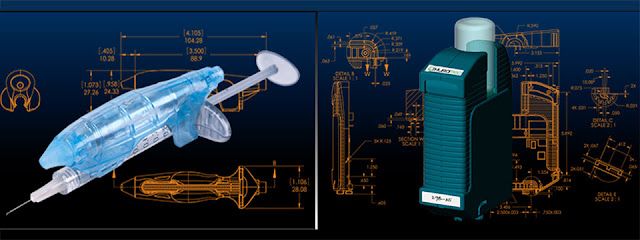Prototype Machining, the Equipment It Is Used Widely
How much do you know process of prototype machining? How much do you know which machining equipments can produce the right prototypes.
CNC milling
1.
Manual milling and CNC milling
Manual milling is the process of removing a material from a
workpiece by using a rotary tool.. But nowadays, a more advanced milling
machine called CNC milling is gradually replacing manual milling machines, it
brings a variety of benefits for both the machining providers and the clients
that outsource the production of their components.Comparing to manual milling, CNC
milling has benefits of more precision, higher production, less labor and
better uniformity.
CNC milling machines can be controlled not only by computer but
also via manual override. Computer programming allows the machine to make the
precise cuts accordingly but the manual function allows an operator to slow
down or speed up or tweak the process at any time.
2.
Multi-axis CNC milling
As technology
develops, multi-axis CNC milling machines were invented, this brings more convenience to prototype and
production. There are 3,4,5 axes CNC milling machines.
5-axis machining offers unlimited possibilities for part size and
shape that you can handle efficiently. The term “5-axis” refers to the number
of directions which the cutting tool can move in. On a 5-axis machining center,
the cutting tool can move across the X, Y and Z linear axes as well as rotates
on the A and B axes to approach
the workpiece from each direction. This means that you can machine five faces
of a part in a single setup. Of cause, with such wonderful function,
CNC prototyping cost of process in 5-axis machines will be more
expensive than those in 3 or 4 axis machines.
Turning
Turning is a cutting tool (usually a non-rotating tool) that
describes the machining of a spiral tool path by more or less linear motion
while the workpiece remains rotating.
During the turning process, a variety of operations can be
performed to the workpiece to yield the desired part shape. These
operations may be classified as external or internal. External operations
modify the outer diameter of the workpiece, like turning, facing, grooving, cut-off and thread cutting.
Internal operations modify the inner diameter, such as drilling, boring,
reaming and tapping. These operations are commonly used in lots of machined
parts.
Sinker EDM
Electrical discharge machining (EDM), also known
as spark eroding, spark machining, burning or die
sinking, is a commonly used manufacturing method to obtain a custom shape.
The material is removed from the workpiece by a series of rapid
cycle current discharges between the electrodes separated by a dielectric
liquid and controlled by voltage.
EDM is the most widely used in mold making, tools, molds and other
industries, but it is becoming a common method of manufacturing prototypes and
producing parts, especially in the aerospace, automotive, electronics and other
industries with relatively low production volumes.
Electrostatic discharge machining requires electrodes, insulating
fluids, and power supplies. The power supply connects the electrode to the
workpiece. The spark generated by the connection creates a channel. Unlike wire
EDM, sinking EDM does not completely cut the material. This allows our
operators to generate complex shapes. At the same time, it does not create
stress in the material. This makes it an excellent means of producing injection
molds and stamping dies. But comparing to CNC milling and turning, the process
speed of sinker EDM is slower. Besides, surface will be rougher.
Wire EDM
Wire EDM, as its name suggests, uses wire discharge current to
feed conductive metal parts. Both the wire and the workpiece are located below
the dielectric layer. This wire is thin and tight. It acts as a cathode in this
process and usually penetrates the material completely, and the operator can
adjust this to cut only the part, but a complete cut is more common. The result
is a very precise cut.
Advantages of CNC prototype machining
With combination of above equipment, custom machining brings a lot
of benefits to manufacturers. These benefits include:
1.
Save manufacturing costs
By using CNC service, you can take advantage of all the raw
materials involved in the manufacturing process. Due to the precise operation
of CNC machines, waste is greatly reduced. This helps CNC machine operators
minimize any losses they may suffer and increase profitability over time.
2.
Increase production speed
CNC machining is a very efficient machining method. Because of
this, the production process of CNC machine tools reduces the number of steps
required to produce a specific part. As a result, you can produce multiple parts
or projects in less time than other manufacturing processes.
3.
Increasing the safety
The entire CNC prototype machine is automated. Therefore, the
machine operator does not even participate in the production process. This
creates a safe environment because the machine can do all the work without
anyone present. Some production involves potentially hazardous materials such
as metals or steel. CNC machining is so precise that it poses virtually no
safety risk.
4.
Improve production efficiency
CNC machine tools are considered to be the most effective system
for designing parts. This is because most CNC machines are equipped with built-in quality
assurance protection. Therefore, when a problem occurs during production, the machine
detects it and closes it to prevent further problems or fix the problem
internally.
5.
Reduce production costs
A properly functioning CNC machine should work flawlessly for a
long time without the need to repair parts or repair the machine in any other
way. Since there is a good production process from the beginning, and because
there are few defects, there is a few maintenance work, so the production cost
is very low. The budget of any company may be significantly reduced by the
manufacturing sector. But with CNC machines, this process can save a lot of
money.
This design was transformed into a physical prototype, which was
time-saving and attracted many customers because of its aesthetics due to the
use of modern rapid prototyping technology. A lot of software are available for
designing purposes now a days which are easy to use and have better interface
as compared to old software.






Comments
Post a Comment